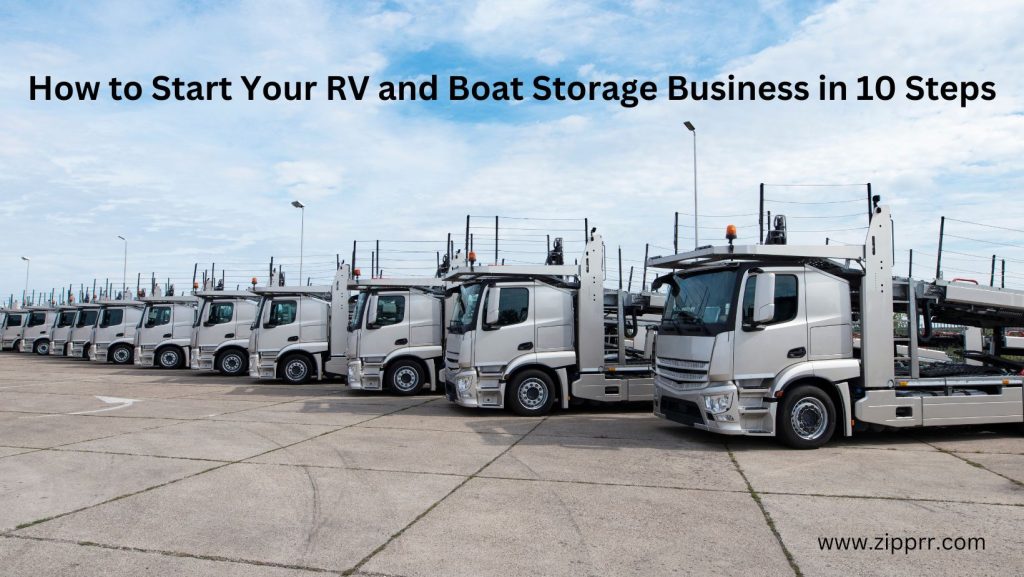This guide will show you step-by-step how to start your own RV and Boat Storage Business. Easy, practical advice to make your venture a success!
Starting a RV Storage Business in 10 Simple Steps
Step 1: Choose a Location
Determine your target market. Decide if you want to cater primarily to RVers in your local area or attract customers from a wider region. This will help you decide on an ideal location.
Research zoning laws. Check your city or county’s zoning regulations to ensure outdoor RV storage is allowed on your chosen property and meets all legal requirements. You may need special permits.
Evaluate accessibility. Prioritize a site that’s conveniently located near major roads and highways for easy customer access. Signage should be clearly visible to passing traffic.
Consider security. Outdoor areas need good lighting and fencing or gating for customer and vehicle safety. Look for a location with existing infrastructure or room for upgrades.
Evaluate space needs. Account fordriveways, parking areas and spacebetween rows to fit large RVs safelywith room to maneuver. Allow for future expansion if demand increases.
Analyze natural features. Ensure the land is reasonably flat and durable to withstand heavy vehicles. Watch out for floods, rockiness or other conditions that could impact usability or damage vehicles long-term.
Gauge expenses. Property taxes, utilities and other costs will affect your pricing. Choose an affordable location within your targeted customer radius.
Step 2: Get Necessary Permits and Licenses
| Permit/License | Purpose | Issuing Authority |
|---|---|---|
| Zoning permit | Confirm your planned business use is compliant with local zoning laws. | City/County planning department. |
| Business license | Allows you to legally operate your business. | City/County business licensing office. |
| Building permit | Required for any permanent structures like storage units, fences or offices. | City/County building department. |
| Sign permit | Approve placement and size of any signage advertising your business. | City/County planning department. |
| Environmental permit | Regulate handling of any potential pollutants. | State environmental protection agency. |
| Fencing/gate permit | Approve installation of security fencing and/or gates. | City/County planning department. |
| Tax registration | Obtain sales tax ID and file as a business for tax collection/reporting. | State department of taxation. |
Step 3: Design Storage Layout and Build Storage Units
How to Design:
- Draw a site map with accurate measurements of your property
- Calculate the number of units that can safely fit while allowing vehicle access
- Determine standard unit sizes (e.g. 10×20, 10×30) suitable for most RVs
- Space units at least 10-15 feet apart for emergency vehicle access
Design Tips:
- Use straight rows for simple maneuvering
- Place larger units on outside ends for bigger vehicle turning radii
- Include small offices or utility areas as needed
- Leave extra space for expansion if property allows
- Designate drive aisles clearly with signage or paint striping
Building Tips:
- Construct hard-walled units out of durable materials like metal siding
- Install lockable doors and overhead lighting in each unit
- Add electricity, cable/internet hookups if budget allows
- Create concrete pads or crushed stone floors for stability
- Consider raised floors to prevent flooding or dampness
- Equip with fire suppression like hydrants or extinguishers
- Landscape with gravel, dirt or pavers between units
Step 4: Set Up Security and Emergency Systems
Install perimeter fencing and locking gates around the entire property. Ensure the fencing is high enough to deter unauthorized access. Make sure the gates can be securely locked when unattended.
Equip the facility with security lighting. Cover the entire yard with bright lighting that activates at dusk and remains on all night. Motion-activated lights along the fence line provide added detection.
Implement 24/7 video surveillance. Position security cameras to monitor entry gates as well as views down rows of storage units. Record surveillance footage for a minimum of 30 days in case any incidents need review.
Provide emergency contact information prominently. Post signs with after-hours phone numbers for owners/managers in case of emergencies on the property. Store phone trees internally for crisis response.
Supply fire prevention tools. Equip the facility with fire extinguishers mounted throughout and ensure hydrants are serviceable if water is available. Conduct annual inspections and replacements as needed.
Establish safety protocols. Create a written emergency action plan outlining procedures for issues like medical emergencies, wildfires or severe weather events. Train all staff.
Consider offering additional security options like a guard dog’s presence or professionally monitored alarms for RVs. Extra precautions provide reassurance to customers.
Step 5: Establish Pricing and Payment Plans
| Storage Type | Size | Monthly Rate |
|---|---|---|
| Outdoor Uncovered | Up to 25′ | $75 |
| Outdoor Uncovered | 26′-35′ | $100 |
| Outdoor Uncovered | 36′-45′ | $125 |
| outdoor covered | Up to 25′ | $100 |
| Outdoor covered | 26′-35′ | $125 |
| Outdoor covered | 36′-45′ | $150 |
| Indoor Uncovered | Up to 25′ | $150 |
| Indoor Uncovered | 26′-35′ | $175 |
| Indoor Uncovered | 36′-45′ | $200 |
| Payment Plans | Monthly | Rates above |
| Payment Plans | Quarterly | 5% discount |
| Payment Plans | Annual | 10% discount |
Step 6: Create a Website and Online Presence
Website Creation:
- Decide on a domain name and register it
- Choose a website builder platform like Wix or Squarespace for the design template
- Populate the site with company information, photos and booking features
SEO Optimization:
- Include relevant keywords in the text, urls and metadata
- Get your business listed on Google Maps, Yelp and other local directories
- Optimize site speed and posting regularly to increase search rankings
Online Booking:
- Set up an reservation/payment system to book spaces online
- Offer mobile-friendly booking that customers can do on-the-go
- Integrate online calendar booking widgets on the website
Step 7: Launch Marketing Campaign
Google Ads/Facebook Ads:
Pros: Target local audience, trackable.
Cons: Upfront costs, learning curve.
Cost: $500-1000/monthDirect Mail Postcards:
Pros: Effective for locals, tangible.
Cons: Limited tracking, bulk mailing costs.
Cost: $500-1000 for 5,000 pieces delivered.Newspaper Ads:
Pros: Trusted local source, easy to design.
Cons: High costs, limited targeting.
Cost: $200-500/ad depending on size.Community Events Sponsorship:
Pros: Visibility, goodwill.
Cons: Limited direct leads.
Cost: $100-500 depending on event.Couponing/Discounts:
Pros: Drives traffic, incentivizes visits.
Cons: Short term effects, impacts margins.
Cost: Varies by size of discounts offered.Public Relations Outreach:
Pros: Earned media coverage, credibility.
Cons: Requires relationship-building over time.
Cost: $500-1000 for local media pitches/outreach.
Starting with 1-2 tactics and monitoring results will allow refinements before committing larger portions of your budget. Tracking leads and conversions is key.
Step 8: Hire Staff as Needed
As your business grows, you may require additional hands to assist with operations. Determine the key roles needed such as managers, maintenance technicians and customer service representatives. Clearly define the roles, responsibilities and qualifications and post job listings on platforms like Craigslist or Indeed.
When screening candidates, prioritize those with relevant skillsets. Mechanics or carpenters could serve as maintenance techs while customer service professionals make good office staff. Look for team players who are reliable, responsive and able to represent your business well. Conduct interviews to assess personalities and troubleshoot any red flags. Request reference checks and background checks as needed.
Provide thorough onboarding and training for new hires. Orient them to business policies, protocols and expectations. Train maintenance staff on repair procedures, tool usage and safety standards. Educate customer service reps on systems, rate schedules and common queries. Clearly communicate guidelines for handling issues, documentation and more. Ongoing training and feedback sessions can help employees to perform well and retain them long-term as roles evolve with growth.
Step 9: Launch Operations and Track Finances
Open your doors for business on the planned start date after all preparations.
Have proper signage installed and website booked for initial customer arrivals.
Set up financial systems to track revenues, expenses, payables and receivables.
Monitor cash flow closely in early months as you build customer base. Have buffer funds available.
Generate monthly financial reports detailing income statement, balance sheet and key metrics like occupancy rates. Assess gaps between targets and actuals.
Step 10: Continue to Improve and Expand
Once your RV and boat storage business is up and running, it’s important to continue improving and looking for ways to expand. Survey your customers regularly to see how you can enhance their experience and solve any problems they may be encountering.
Also, look for opportunities to expand your available storage space as demand increases. You may need to build additional units on your property over time. Continuing to enhance your offerings will allow you to attract more clients and grow your business.
Additionally, explore related services like maintenance and repairs that can boost your revenue streams. Constant improvement is key to ensuring your business remains successful for years to come.
How much it cost to start an RV & Boat storage business?
| Cost | Estimate |
|---|---|
| Land purchase | Varies greatly based on location and size, but plan for $100,000-$500,000 |
| Construction of storage units | $25,000-$50,000 per standard unit |
| Fencing/gating around property | $10,000-$25,000 |
| Office supplies, furniture, appliances | $2,000-$5,000 |
| Business licenses and permits | $500-1,000 |
| Insurance (general liability, property) | $1,000-3,000 annually |
| Website development | $1,000-$3,000 |
| Signage | $1,000-$2,000 |
| Payment processing fees (credit cards) | 2-4% per transaction |
| Software for reservations, payments, inventory | $100-500 per month |
| Training and legal assistance to start the business | $1,000-3,000 |
| Emergency funds/working capital | $10,000-20,000 |
Meet Zipprr - Your Storage Business Website Solution
Zipprr is an online marketplace designed specifically for storage business owners. On Zipprr, you can purchase professionally designed, fully functional websites tailored for RV, boat, and vehicle storage facilities. Each template is responsive, bookings and payments integrated, and easy to customize with your business information and photos. No web design or coding experience required.
Just choose from a range of affordable package options, complete the simple setup, and you’ll have an effective online presence up and running within hours. Zipprr takes the hassle out of design and programming, so you can focus on growing your storage business.
Wrap Up
Starting an RV and boat storage business can be a rewarding entrepreneurial venture if done right. Carefully research your local market, secure financing, obtain necessary permits, build or lease a suitable facility, and market your services. With proper planning and hard work, you can successfully launch a storage business to store and protect customers’ prized recreational vehicles.







